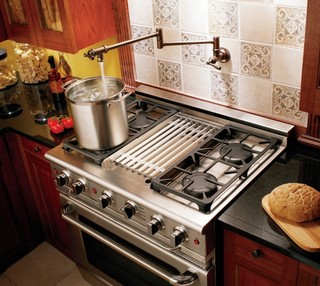"Oh no!" I said. "We don't need anything fancy like that." I mean, I'm not into cooking. I don't need any bells and whistle.
But the idea stuck. And Troy said it would be easy to plumb, and he thought cheap.
Over time I became convinced. "Why not?" was my biggest argument, but I also realized that it would help a lot with canning. Those big pots are unwieldy to fill with water and move around (to say the least).
So we planned on a pot filler. But which one?
I had been looking through a lot of magazines, and they all showed pot fillers like the one above--two-jointed contraptions with a couple of taps to turn the water on and off. They were way too much for what I wanted, and I didn't think they would suit the kitchen at all.
I then found a couple of examples of simpler and smaller faucets, like the one to the right from Chicago Faucets. It's about 6" and has just one joint and one tap. I thought this would suit me and my kitchen much more. I dutifully cut out the pictures and put it in my binder for when we would need it.
Then one Thursday when our walls were still open and Troy was working on the plumbing, he tells me he needs the faucet by the weekend because he's going to plumb the pot filler and needs to have the faucet in hand to do it. So I start researching where to get it. There is a retailer that carries Chicago Faucets so I head there on Saturday morning. They don't have what I need in stock (they can get it in two weeks), but they have a few models like in the first picture. They are in stock. (They're not really what I want.) And they start at $1,200. Yeah. Ouch.
So I do a marathon run of the local big box stores (the other plumbing supply place is closed on Saturdays, but that doesn't mean I don't have to drive all the way there to find that out) and find nothing. Some of them have similar faucets as low as $800, but all of them have to order it in.
I return home in defeat and Troy says that he can do it with basic fittings, copper pipes and a ball valve for $20 or less. Guess what we decide to go with.
We saved a lot of money, but it wasn't all clear sailing. The first ball valve was defective and started leaking after Troy had it installed. There was also the time he sent me for plumbing parts. No specifics, just "I need parts to connect this type of pipe to that type of fitting." It didn't get off to a good start when the store staff told me the first part that I asked about didn't exist. (I knew it did; I had bought one before.) So I wandered the aisle looking for various ways I could make the connections. Not only a mental exercise in what combination of options would work but also an exercise in cleaning up the stock bins.
But anyway, we got it done and for months we have had this "faucet" poking out of the wall above our stove. It's plumbed, there's water there, but we couldn't use it because it wasn't finished with pipes to direct the water into the pots.
Troy added a copper pipe with a 90 degree elbow. The height is perfect over the canner.
For smaller pots, we have an extension to keep the water from making a mess:
I'm happy with how the faucet doesn't dominate the stove area.
Oh? You want to see it in action? Ok, here you go:







No comments:
Post a Comment